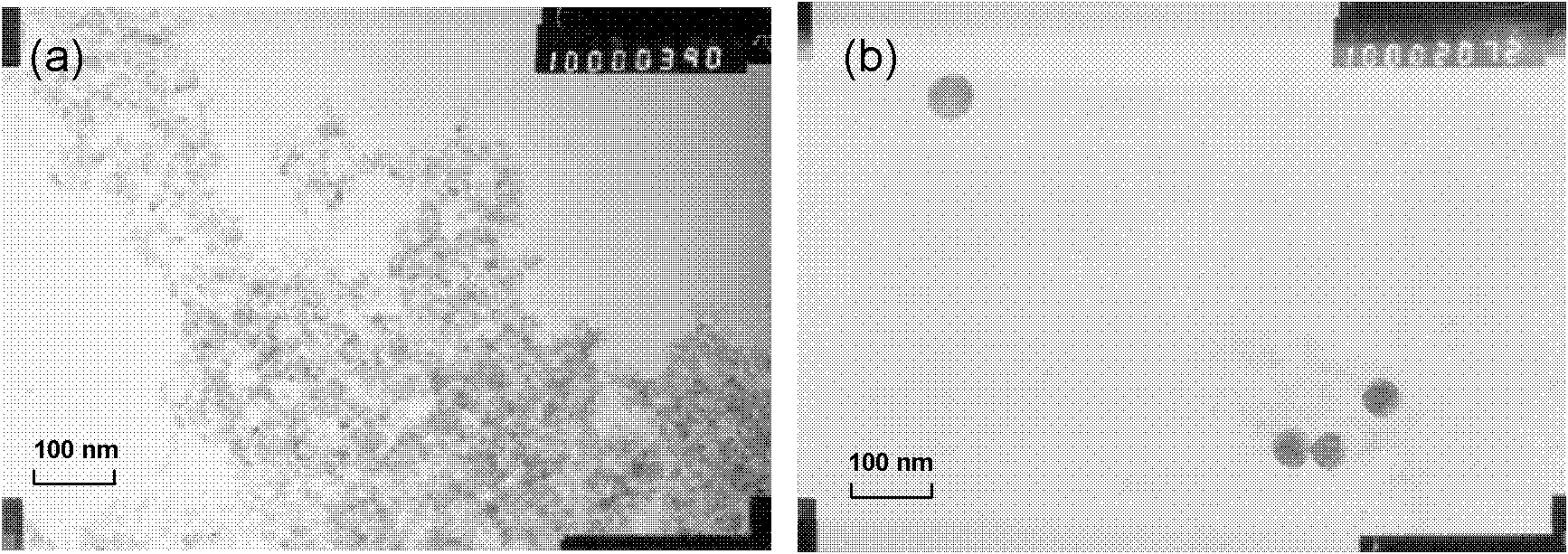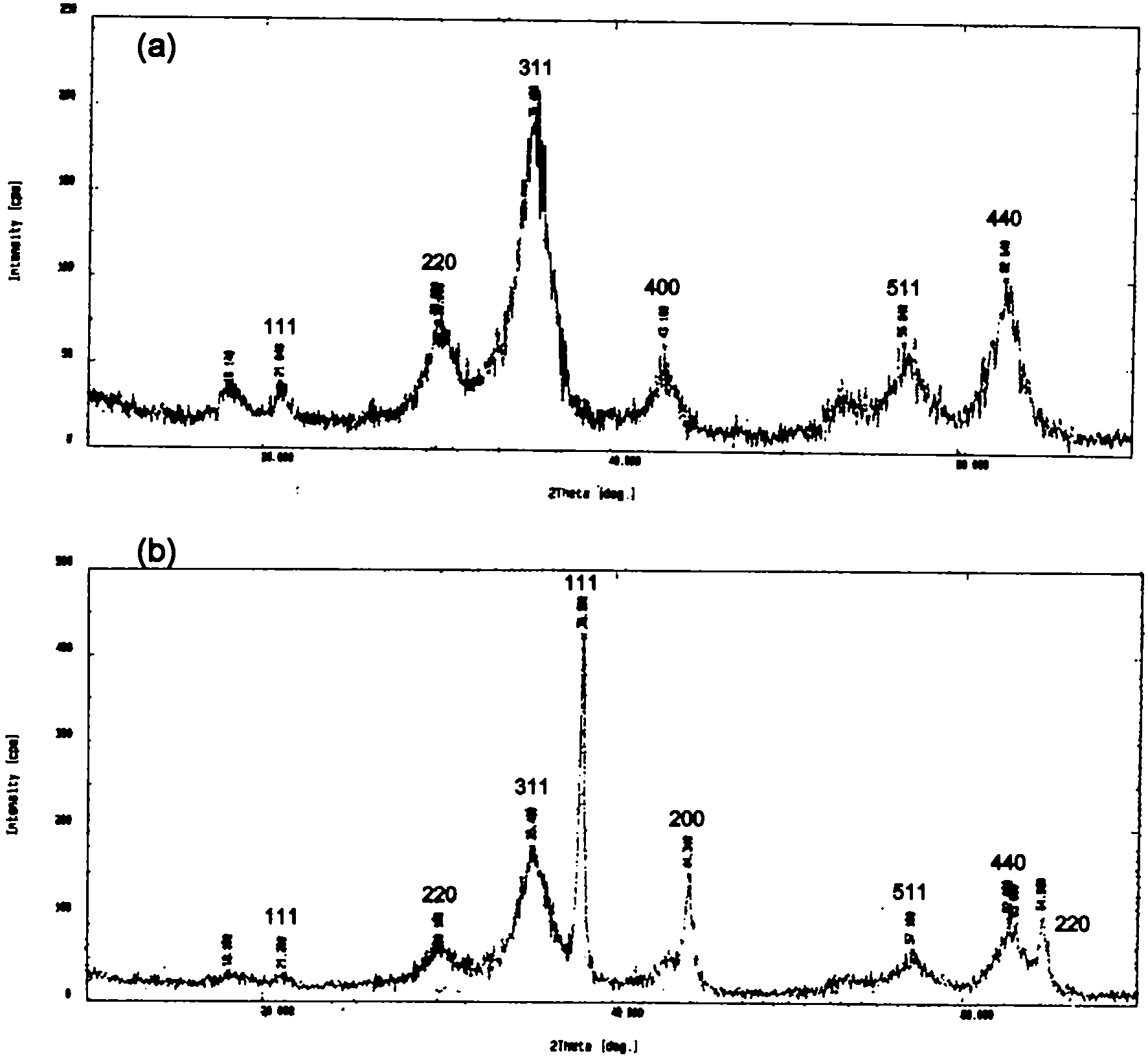Cell sorting magnetic bead, synthesis method thereof and application thereof in cell sorting
A technology of magnetic beads and cells, applied in the field of nano-biological applications in materials science and biochemistry, can solve the problems of small protein coupling, high separation cost and complicated operation.
- Summary
- Abstract
- Description
- Claims
- Application Information
AI Technical Summary
Problems solved by technology
Method used
Image
Examples
Embodiment 1
[0035] Example 1: Fe 3 o 4 Preparation and Characterization of @Au Nanoparticles
[0036] 1. Fe 3 o 4 Preparation of (15nm) nanoparticles
[0037] a.5.2g FeCl 3 6H 2 O, 2.0g FeCl 2 4H 2 O was dissolved in 40mmol / L HCl aqueous solution to make iron salt solution;
[0038] b. Under sufficient mechanical stirring, add the prepared iron salt solution dropwise into 250mL 1.5mol / L NaOH aqueous solution, and keep the temperature at 80°C during the whole process;
[0039] c. Fe produced 3 o 4 Nanoparticles were separated by a magnet, collected and washed 4 times with 200mL pure water, dispersed in 100mL pure water to make 0.1mol / L Fe 3 o 4 storage solution.
[0040] 2. Fe 3 o 4 Preparation of @Au(50-70nm) nanoparticles ( figure 1 )
[0041] a.5mL 0.1mol / L Fe 3 o 4 Stock solution and 1.5mL 0.2mol / L NH 2 Add OH HCl aqueous solution dropwise to 75mL 0.01mol / L TMAOH aqueous solution and heat to 80°C;
[0042] b. Under full stirring, 40mL 0.1% (w / v) HAuCl 4 Add the ...
Embodiment 2
[0046] Example 2: Preparation and purification of mouse CD3 monoclonal antibody
[0047] 1. Preparation of mouse CD3 monoclonal antibody
[0048] a. Place the anti-mouse CD3 monoclonal antibody hybridoma cell line in the cell culture medium at 37°C and 5% CO 2 , change the cell culture medium every 2 days until the cell concentration is greater than 10 5 Stop changing the liquid when each hole is used;
[0049] b. Inject paraffin oil into the peritoneal cavity of healthy Balb / c mice several days before antibody mass production. Blow down a certain number of monoclonal cells with sterile PBS solution, centrifuge at 1,000rpm for 3-5min, resuspend the cell pellet in 0.5mL PBS, and inject it into the abdominal cavity of the mouse;
[0050] c. 7-10 days after the monoclonal cells were injected into the mouse, the abdomen of the mouse was obviously swollen, and the ascites was collected. Fix the mouse with the left hand, disinfect its abdomen with 75% alcohol, then place a test ...
Embodiment 3
[0058] Example 3: Directional coupling of mouse CD3 antibody on magnetic beads ( Figure 6 )
[0059] 1. Fe 3 o 4 Surface carboxylation of @Au nanoparticles
[0060] a. Weigh 25mg Fe 3 o 4 @Au nanoparticles were ultrasonically dispersed in 10mL ethanol solution containing 20mmol / L 16-mercaptohexadecanoic acid, and ultrasonically reacted for 48h;
[0061] b. After the reaction, wash the magnetic bead solution with ethanol for 3 times, centrifuge at 9,000rpm for 15min, and redisperse into 12.5mL ethanol to prepare a 2mg / mL carboxylated magnetic bead dispersion.
[0062] 2. Coupling of CD3 antibody on magnetic beads
[0063] a. Take 500μL 2mg / mL carboxylated magnetic bead dispersion, discard the ethanol after magnetic separation, redisperse in 1mL aqueous solution containing 20mg / mL EDC and 10mg / mL NHS, ultrasonically react for 1h, every 5min during the reaction Mix the reaction solution thoroughly once;
[0064] b. Separate the activated magnetic beads with a magnet and ...
PUM
 Login to View More
Login to View More Abstract
Description
Claims
Application Information
 Login to View More
Login to View More - R&D
- Intellectual Property
- Life Sciences
- Materials
- Tech Scout
- Unparalleled Data Quality
- Higher Quality Content
- 60% Fewer Hallucinations
Browse by: Latest US Patents, China's latest patents, Technical Efficacy Thesaurus, Application Domain, Technology Topic, Popular Technical Reports.
© 2025 PatSnap. All rights reserved.Legal|Privacy policy|Modern Slavery Act Transparency Statement|Sitemap|About US| Contact US: help@patsnap.com



